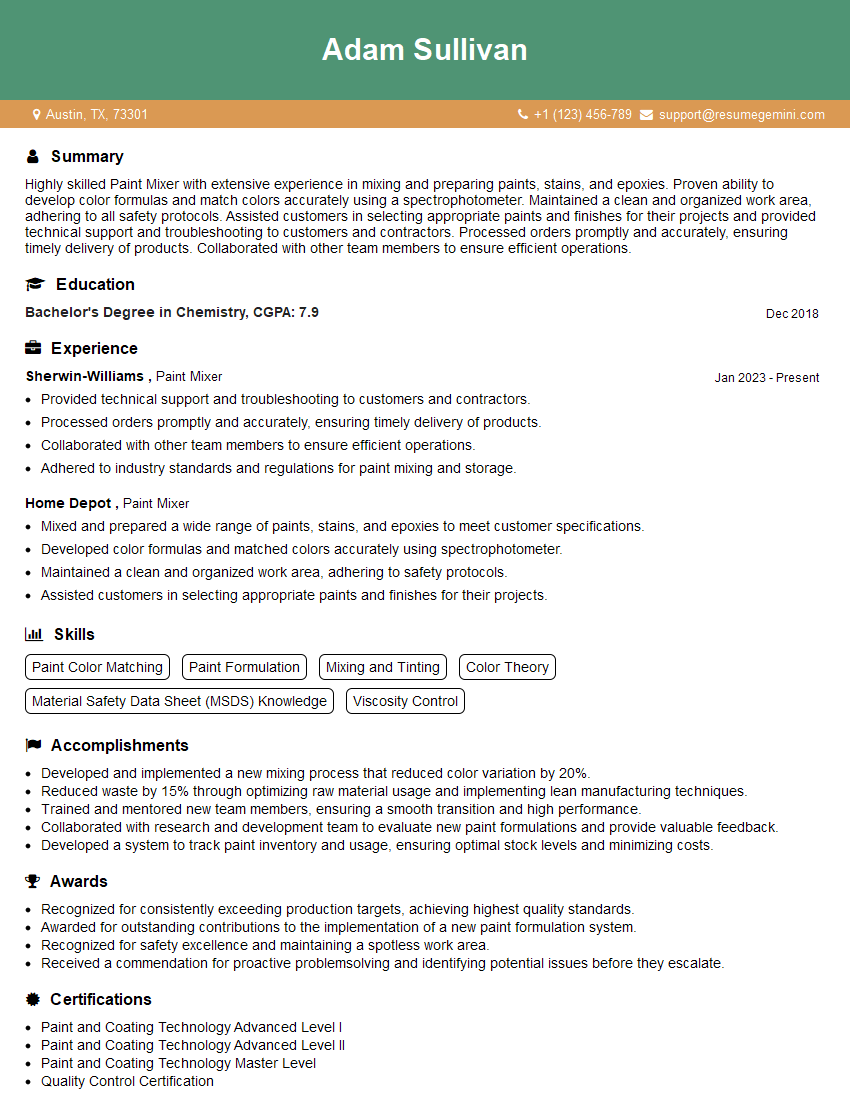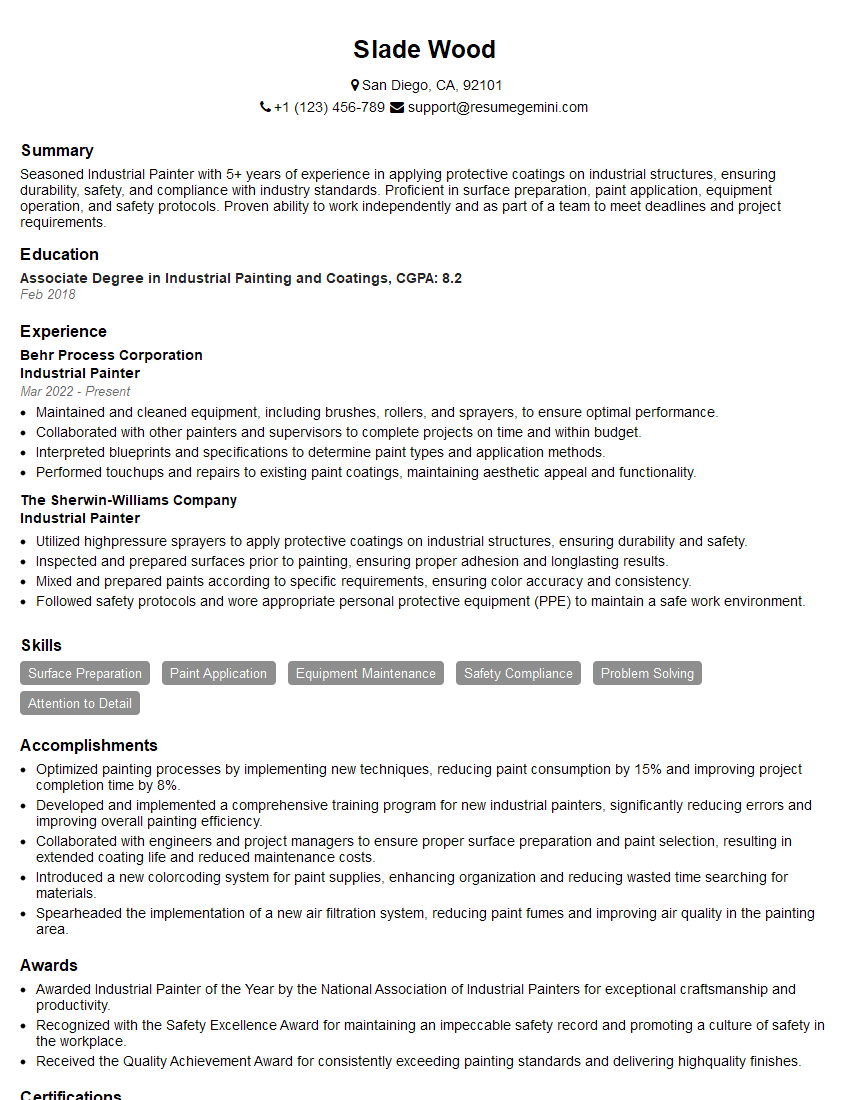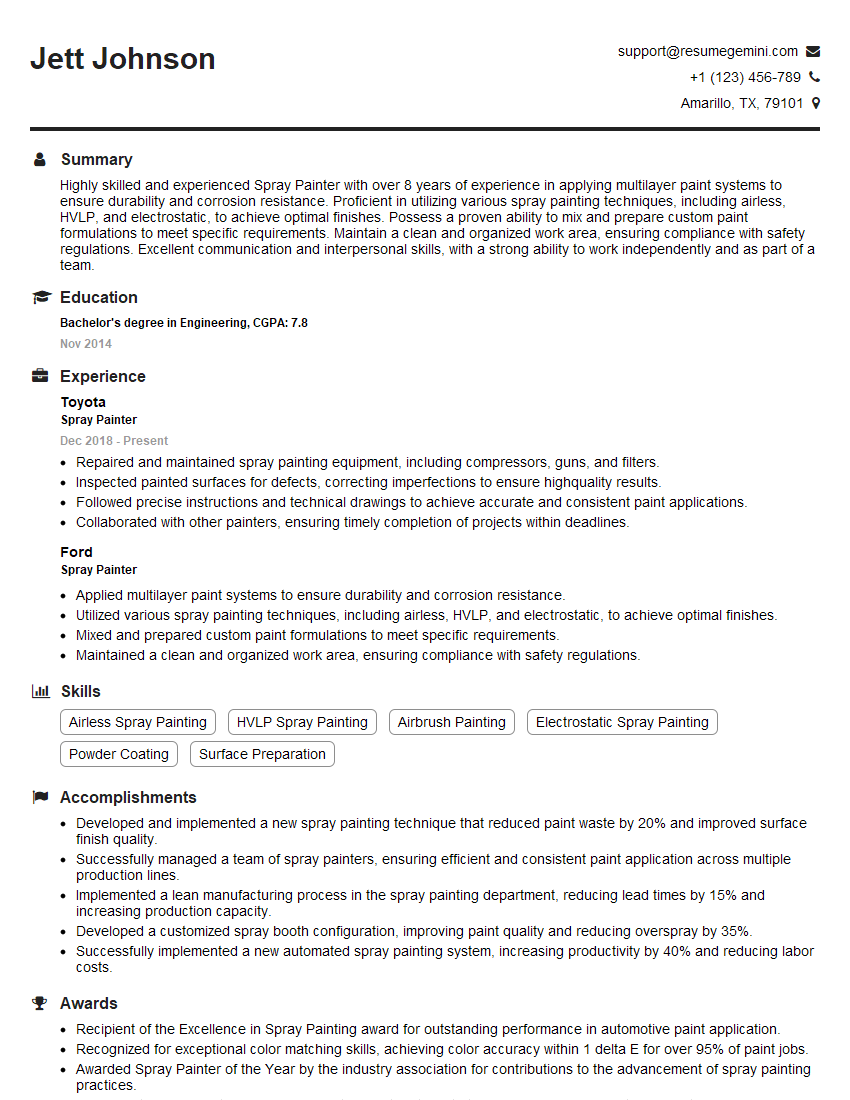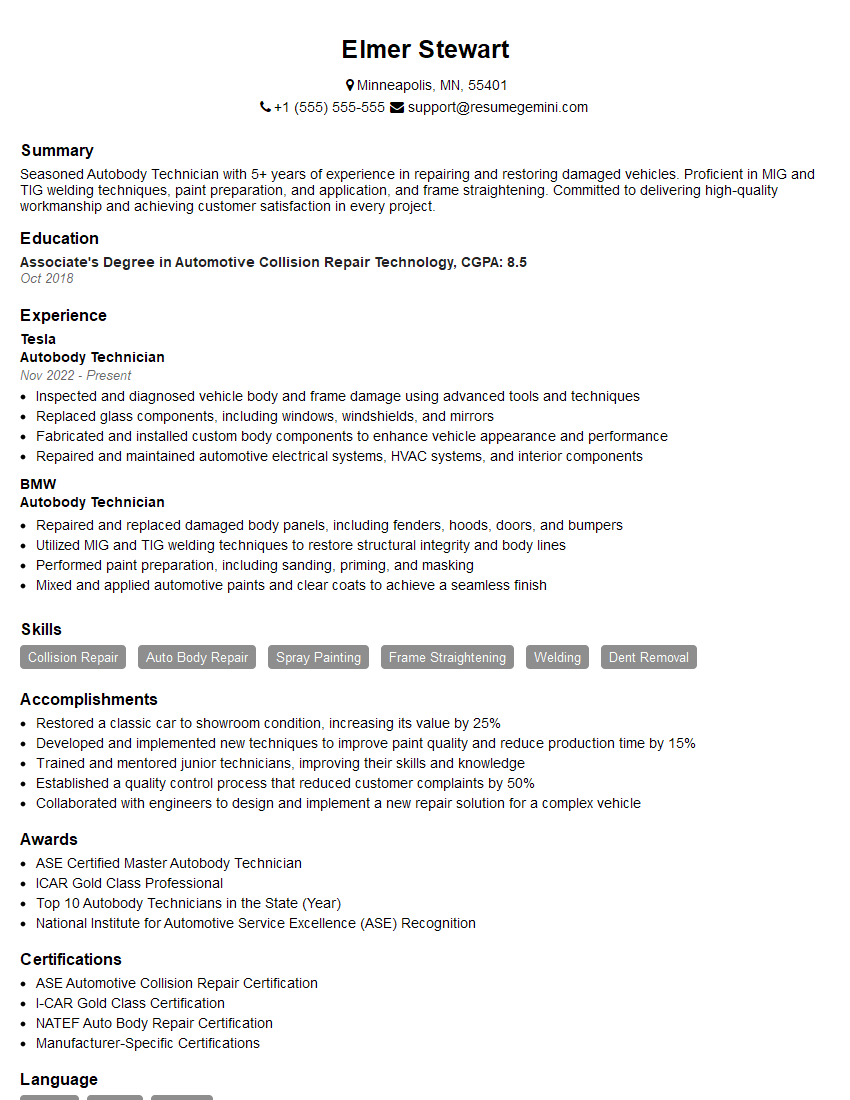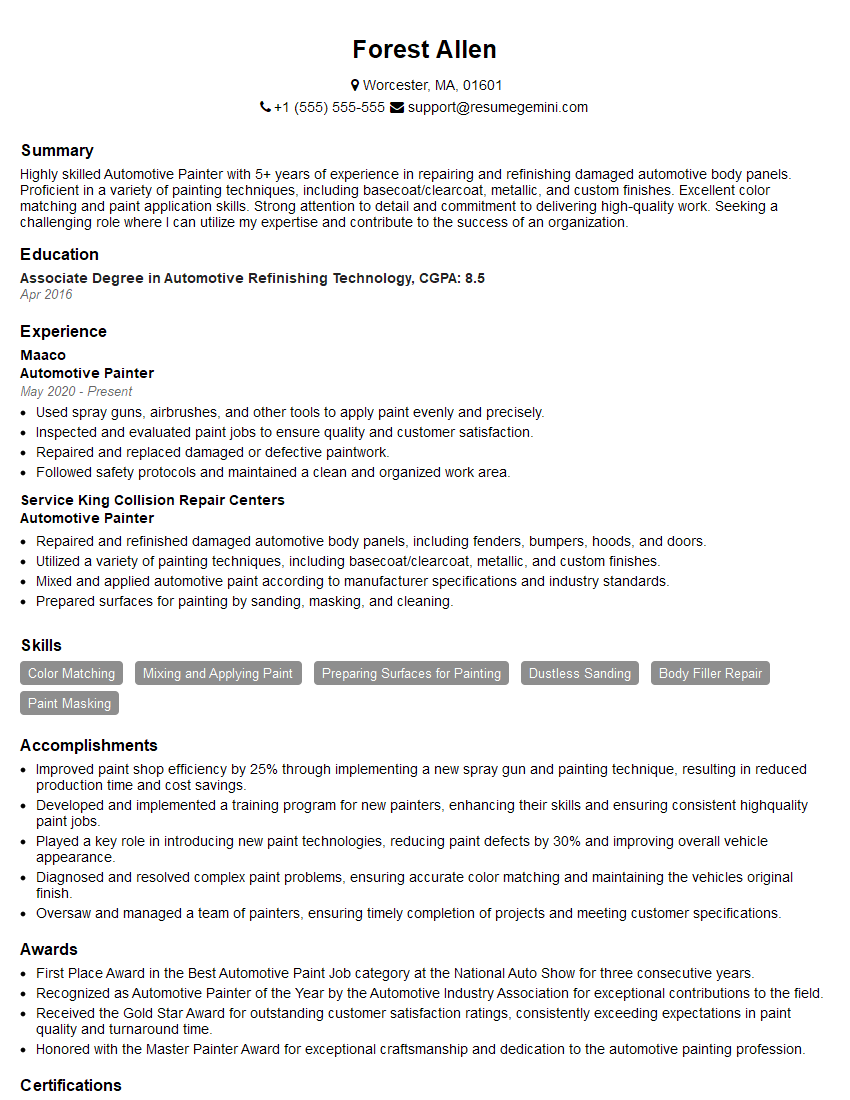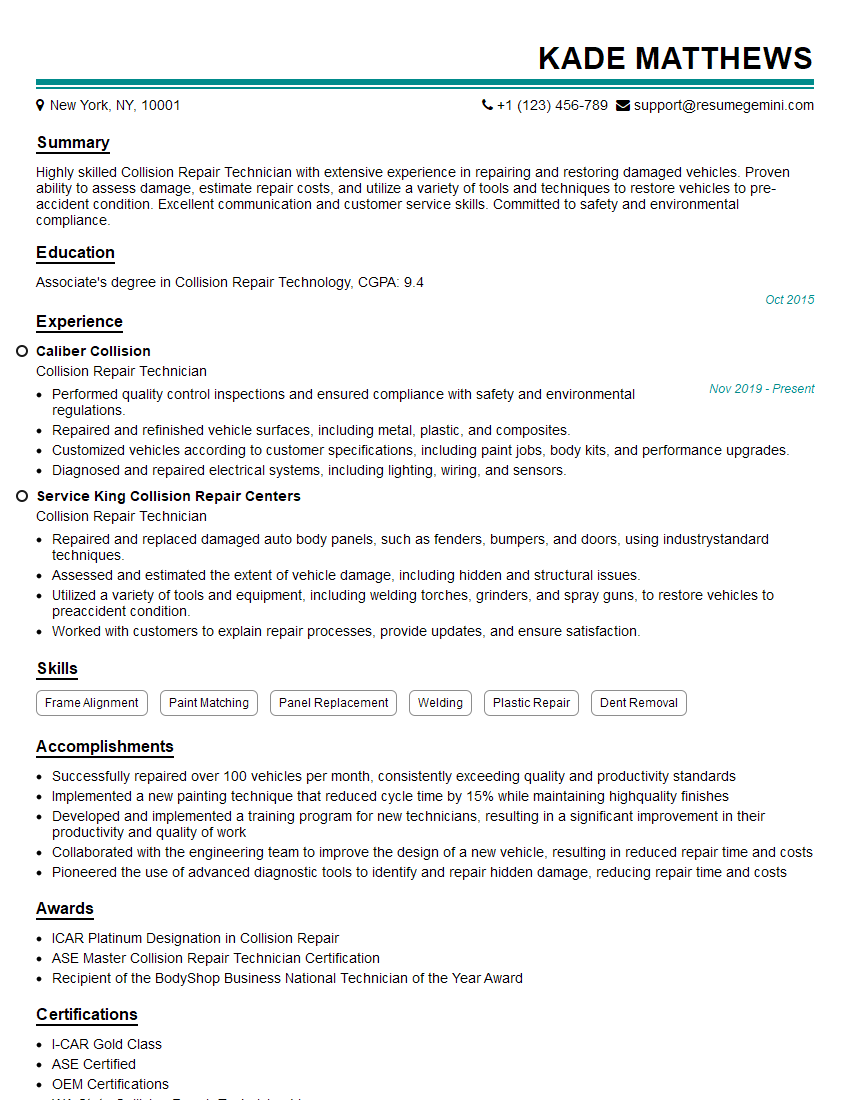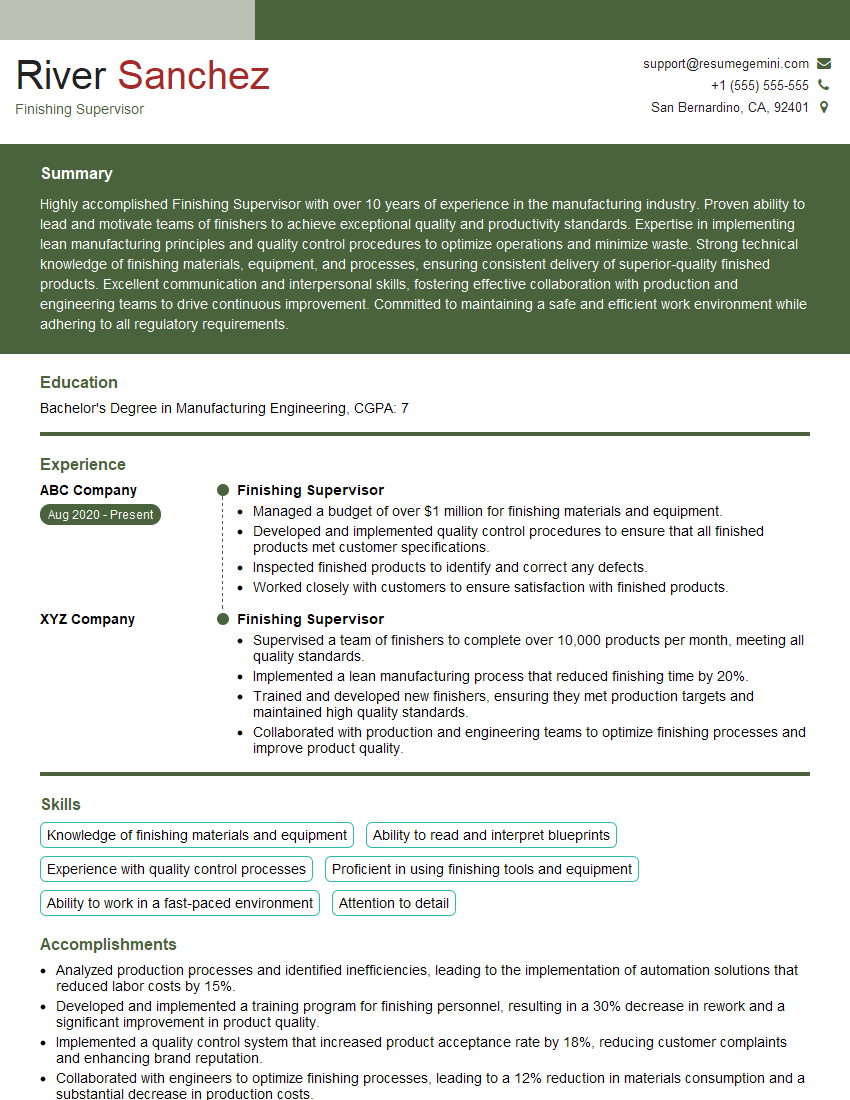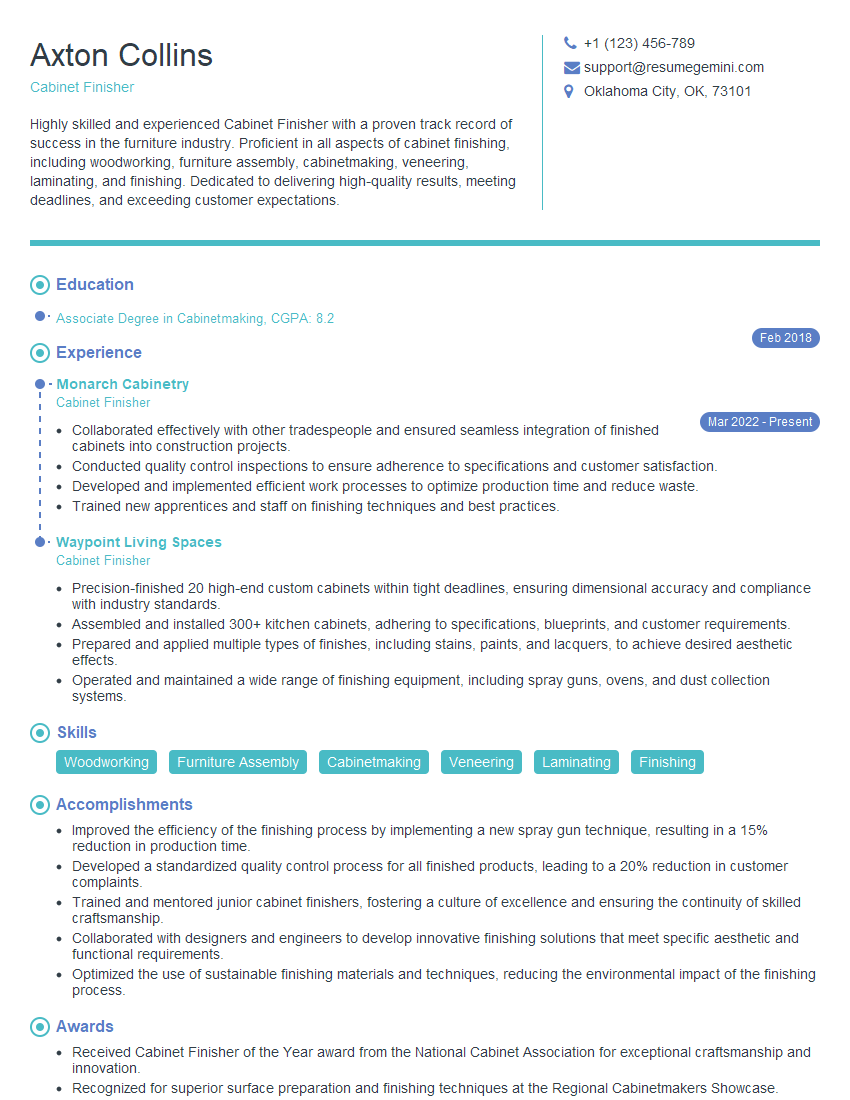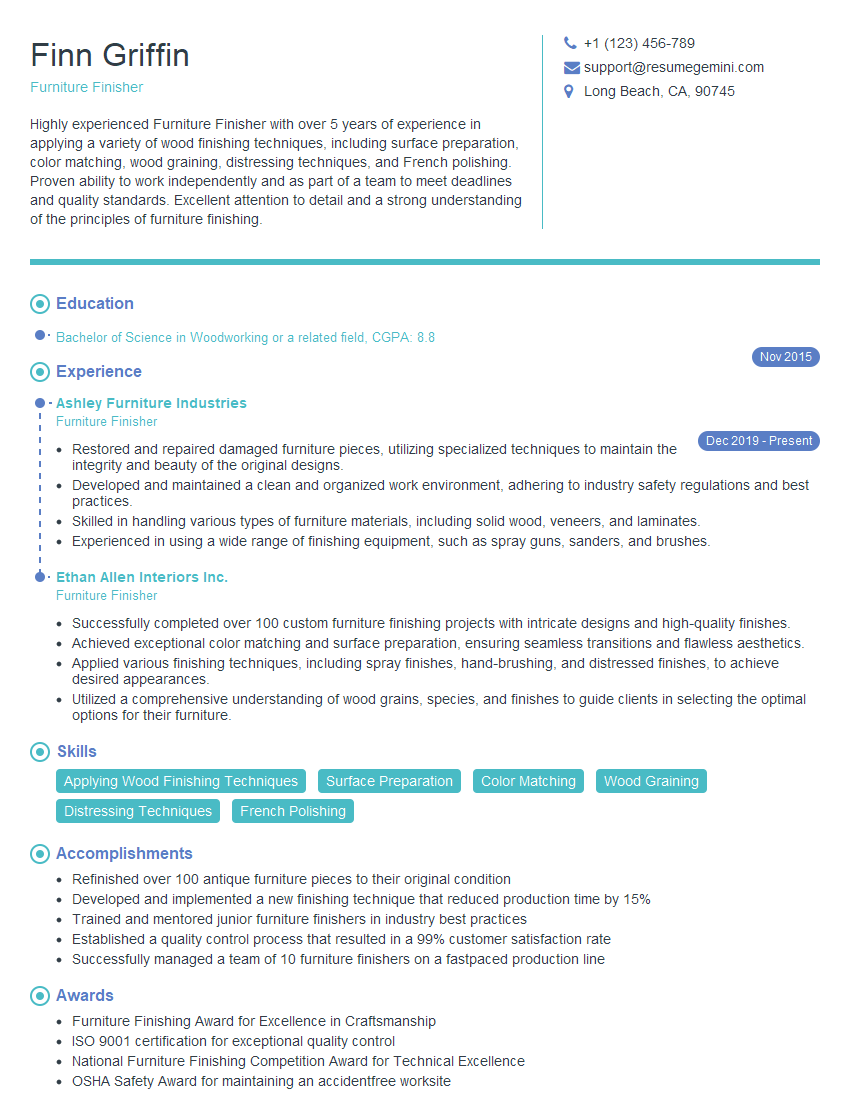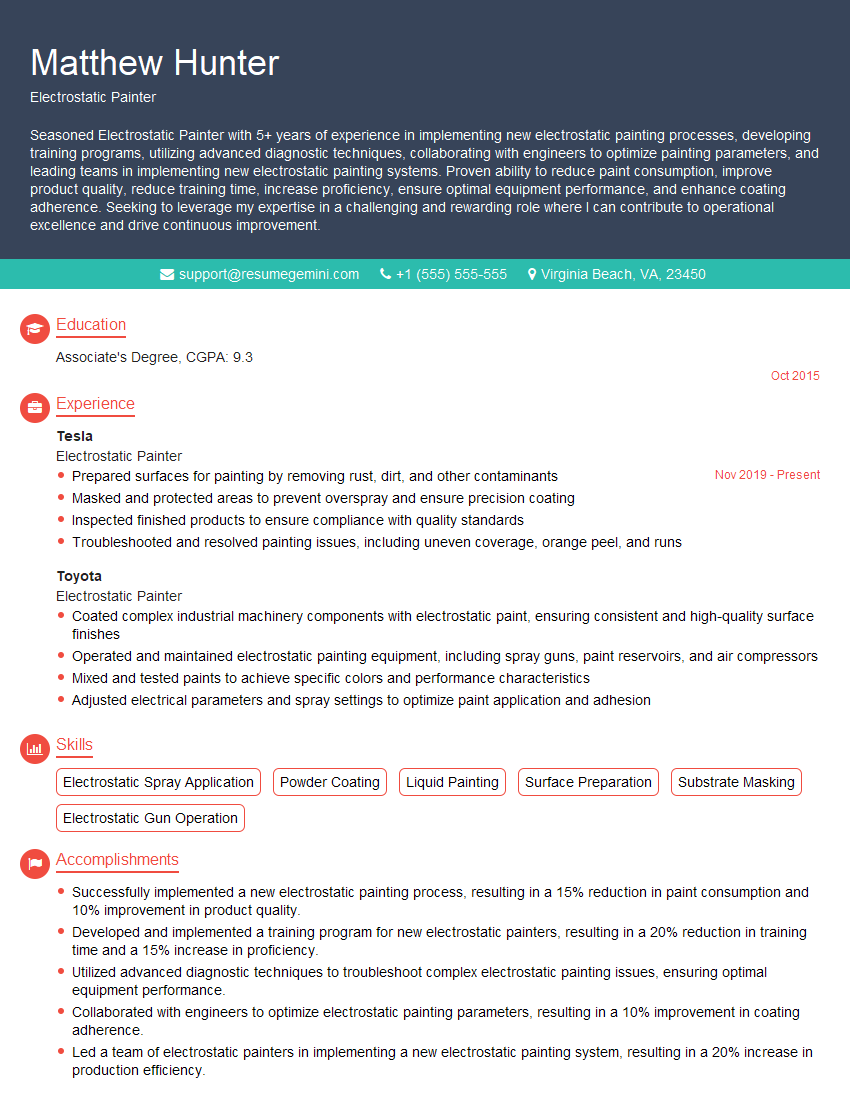The right preparation can turn an interview into an opportunity to showcase your expertise. This guide to Paint and Finishing interview questions is your ultimate resource, providing key insights and tips to help you ace your responses and stand out as a top candidate.
Questions Asked in Paint and Finishing Interview
Q 1. What types of surface preparation are necessary before applying paint?
Proper surface preparation is paramount for a durable and aesthetically pleasing paint finish. Think of it like building a house – you wouldn’t start constructing without a solid foundation. Neglecting this step leads to premature paint failure, such as peeling or chipping.
- Cleaning: This involves removing dirt, dust, grease, and any loose or flaking paint. I typically use appropriate detergents, pressure washing (where suitable), or even abrasive blasting for heavily soiled surfaces. For example, preparing a rusty metal surface would necessitate wire brushing or chemical rust removal before painting.
- Repairing: Filling holes, cracks, and imperfections using appropriate fillers or wood putty is crucial. Once dry, these areas need to be sanded smooth to ensure a seamless transition between the repaired area and the surrounding surface. I often use a variety of fillers depending on the substrate and the size of the imperfection, from lightweight spackle for small holes to epoxy fillers for larger repairs.
- Priming: Applying a primer is essential to improve paint adhesion, especially on porous surfaces like wood or drywall. It provides a uniform surface for the topcoat to adhere to, preventing uneven absorption and improving the overall finish. The choice of primer depends on the substrate and the topcoat – for instance, an oil-based primer may be used for high-gloss finishes or on surfaces prone to bleeding through, while a water-based primer is a more environmentally friendly option for many applications.
- Sanding: After filling and priming, sanding is necessary to create a smooth surface, ensuring a flawless finish. I typically use various grades of sandpaper, starting with coarser grits for significant imperfections and graduating to finer grits for a smooth finish. This step is vital for achieving professional-looking results.
Q 2. Explain the difference between solvent-based and water-based paints.
Solvent-based and water-based paints differ primarily in their binder (the component that binds the pigment particles together), their solvents (the liquids that make them workable), and their drying mechanisms. Choosing the right type depends greatly on the project and the environment.
- Solvent-based paints (also known as oil-based paints): These traditionally use mineral spirits or turpentine as solvents and dry through oxidation and evaporation. They offer excellent durability, hardness, and water resistance, making them ideal for exterior applications or high-traffic areas. However, they have strong odors, take longer to dry, and require specialized cleanup with solvents.
- Water-based paints (also known as latex paints): These use water as their solvent and dry through evaporation. They are lower in VOCs (Volatile Organic Compounds), making them more environmentally friendly. They are usually easier to clean up with water and soap, dry faster, and have less odor. While generally less durable than oil-based paints in extreme conditions, modern water-based paints offer excellent performance in many applications.
For example, I might use a solvent-based paint for a trim application requiring superior durability and water resistance, but opt for a water-based paint for a child’s bedroom to minimize the potential health risks associated with strong solvents.
Q 3. Describe your experience with various paint application methods (e.g., spraying, brushing, rolling).
My experience encompasses all major paint application methods, each with its own strengths and limitations.
- Spraying: Ideal for large, smooth surfaces, spraying provides a consistent, even coat. Airless sprayers are my go-to for speed and efficiency on projects like fences or house exteriors. However, spraying requires careful preparation to avoid overspray and requires specialized equipment and safety precautions.
- Brushing: Best for detailed work and intricate designs, brushing allows for precise control and excellent coverage in hard-to-reach areas. I utilize different brush types depending on the paint and surface – natural bristle brushes for oil-based paints and synthetic brushes for water-based paints. A recent project involved hand-brushing a delicate antique piece of furniture.
- Rolling: Efficient for large, flat surfaces like walls, rolling provides good coverage and is relatively easy to use. Different roller covers are used depending on the texture of the surface and the type of paint. I often use a combination of rolling and brushing to achieve the best results, using a brush to cut in around edges and corners before rolling.
I’ve found that mastering each method is crucial for versatility and achieving high-quality results across diverse projects. The best method always depends on the specific project requirements.
Q 4. How do you ensure consistent color matching?
Maintaining consistent color matching is crucial for professional results. Inconsistent colors can drastically affect the overall aesthetic appeal of a project.
- Using the same batch: The simplest way is to use paint from the same batch number. If multiple gallons are required, I ensure they are mixed thoroughly to ensure color consistency.
- Color matching systems: Professional paint stores often have sophisticated color matching systems. Using a color sample or a color code, they can precisely replicate the desired color using their computerized systems. I rely heavily on these systems for large projects, especially when multiple coats are needed.
- Tint bases: Many paint manufacturers provide universal tint bases, allowing for customized color mixing using pre-determined formulas. This approach is vital when the desired color isn’t readily available in stock.
- Test patches: Before applying paint to the entire surface, I always recommend applying test patches to confirm color consistency, especially in varying lighting conditions.
Careful record-keeping is essential, noting batch numbers and color codes for future reference. This prevents discrepancies when additional paint is needed.
Q 5. What safety precautions do you take when working with paints and solvents?
Safety is my top priority when working with paints and solvents. Exposure to these materials can have serious health consequences.
- Respiratory Protection: I always wear a respirator, particularly when working with solvents or spray painting. This protects my lungs from harmful fumes and dust particles.
- Eye Protection: Safety glasses or goggles are essential to protect my eyes from splashes and dust.
- Skin Protection: I wear gloves appropriate for the materials being used – nitrile gloves are my standard for most paints and solvents. Long sleeves and pants also provide additional protection.
- Ventilation: Adequate ventilation is crucial to minimize exposure to fumes. This could involve using fans, opening windows, or even working outdoors whenever possible.
- Proper Disposal: I always follow local regulations for the proper disposal of paint waste and hazardous materials. Never pour paint down the drain or into the environment.
- Fire Safety: Many solvents are flammable. I always make sure to keep sparks, open flames, and ignition sources away from work areas. I also use and store solvents according to the manufacturer’s guidelines.
Regularly checking the safety data sheets (SDS) for all products used is crucial for staying informed about potential hazards and appropriate safety procedures.
Q 6. How do you handle paint defects or imperfections?
Handling paint defects requires a systematic approach. The type of defect determines the appropriate remediation strategy.
- Surface imperfections: Small imperfections, like minor scratches or blemishes, can be addressed with careful sanding and re-coating. I use finer grits of sandpaper to avoid further damage, followed by a light application of paint.
- Runs and drips: Runs and drips can usually be addressed by allowing the paint to dry completely and then lightly sanding the area smooth before applying another thin coat. If it’s a significant issue, I might need to completely remove the affected area and repaint.
- Orange peel texture: This can be caused by an incorrect spray technique or incorrect viscosity of the paint. A solution could involve applying a subsequent coat with a different application method (such as rolling), or, if severe, lightly sanding and repainting.
- Blistering or peeling: This indicates poor surface preparation or adhesion problems. The damaged area usually needs to be completely scraped and cleaned before repainting, ensuring proper surface preparation before applying a primer and top coat.
Careful observation and diagnosis are key. I often take photographs to document the defect before and after remediation, helping to ensure I’m addressing the root cause and not just treating the symptom. This methodical approach guarantees a long-lasting, professional result.
Q 7. What is your experience with different types of coatings (e.g., epoxy, polyurethane)?
My experience extends to various coating types, each suited for specific applications and offering unique properties.
- Epoxy coatings: These are known for their exceptional hardness, chemical resistance, and durability. They’re ideal for floors, countertops, and other surfaces requiring protection from chemicals or wear and tear. For example, I recently used an epoxy coating system for a commercial kitchen floor, ensuring long-lasting protection against moisture and heavy traffic.
- Polyurethane coatings: These offer excellent abrasion and scratch resistance, UV protection, and flexibility. They’re commonly used in furniture finishing, automotive applications, and marine environments to protect surfaces from environmental factors. I have significant experience applying polyurethane finishes to both wood and metal projects, offering a high-gloss or matte finish depending on the application and client preference.
- Acrylic coatings: Offering good durability and water resistance, acrylic coatings are versatile and widely used in various applications, including interior walls, trim, and outdoor surfaces. Their low VOC content makes them environmentally friendly.
- Other coatings: My experience also includes working with specialized coatings like powder coatings, which are applied electrostatically and then cured in an oven for enhanced durability. I’ve handled numerous projects incorporating these diverse coating systems, adapting my techniques based on the specific requirements of each task.
Understanding the properties and applications of different coatings enables me to choose the best product for any project, ensuring long-lasting, high-quality results. Selecting the wrong coating can have significant negative consequences; proper material selection is critical.
Q 8. Describe your experience with powder coating.
My experience with powder coating spans over 10 years, encompassing various applications from small-scale projects to large-scale industrial jobs. I’m proficient in all stages, from surface preparation and pre-treatment to the actual powder application and curing process. I’ve worked with a wide range of powder coating types, including polyester, epoxy, polyurethane, and hybrid formulations, each with its own unique properties and application requirements. For instance, I’ve successfully managed the powder coating of intricate metal components for the automotive industry, requiring meticulous masking and precision application to avoid imperfections. In another project, I oversaw the coating of large steel structures for a construction project, demanding efficient workflow and careful monitoring of the curing process to ensure uniform thickness and durability. My expertise extends to troubleshooting common powder coating issues like orange peel, pinholes, and fisheyes, and I’m skilled in selecting the appropriate powder type and curing parameters based on the substrate and desired final finish. I’m also well-versed in safety protocols associated with powder coating, including proper handling of hazardous materials and disposal procedures.
Q 9. Explain the importance of proper ventilation in a paint booth.
Proper ventilation in a paint booth is absolutely critical for both worker safety and ensuring a high-quality paint finish. The importance lies in removing airborne contaminants—solvents, overspray, and dust—that can negatively impact both the health of the painter and the finished product. Inadequate ventilation leads to several problems. Firstly, it creates a hazardous working environment, exposing painters to potentially harmful solvents and VOCs (Volatile Organic Compounds). Secondly, airborne contaminants can settle on the wet paint, causing imperfections like dust nibs or causing the paint to not cure properly. Thirdly, an explosive mixture of solvents and air can build up in poorly ventilated spaces, creating a fire hazard. A well-designed paint booth uses a system of air intake and exhaust fans to create a controlled airflow, capturing overspray and quickly removing it from the booth. The air exchange rate is crucial and should be calculated based on the size of the booth and the type of paint being used. For example, water-based paints require less aggressive ventilation than solvent-based paints. Regular maintenance of the ventilation system, including filter cleaning and fan inspections, is essential for optimal performance and worker safety.
Q 10. How do you maintain paint equipment and tools?
Maintaining paint equipment and tools is paramount for efficiency, quality, and longevity. My routine includes daily cleaning of spray guns immediately after use. This involves disassembling the gun, cleaning each part with the appropriate solvent, and reassembling it. Airless sprayers require more extensive maintenance, including flushing the pump with appropriate solvents and checking for leaks. I also regularly inspect hoses and filters for damage or clogging. For brushes and rollers, thorough cleaning with the appropriate solvent is crucial, followed by proper storage to prevent damage or hardening of the bristles/rollers. For example, using the wrong solvent can damage the brush bristles. Periodically, I calibrate the spray equipment to ensure consistent paint application. This involves checking the pressure, fluid flow, and spray pattern. Proper storage of all equipment in a clean, dry environment is essential to prevent corrosion and damage. Regular lubrication of moving parts, such as the air compressor and spray gun components, is also vital. A preventative maintenance schedule prevents major breakdowns and improves the overall life of the equipment, saving costs in the long run.
Q 11. What are the common causes of paint failures?
Paint failures can stem from a variety of causes, all often linked to insufficient preparation or improper application. Common causes include poor surface preparation – a surface that hasn’t been properly cleaned, primed, or sanded will lead to adhesion problems. Another common cause is using incompatible paints or primers. For example, applying oil-based paint over a water-based primer will often lead to peeling or blistering. Incorrect application techniques, such as applying paint too thickly or in poor weather conditions, can also cause problems such as cracking, orange peel, and runs. Environmental factors, like extreme temperatures or humidity, can affect curing and adhesion, resulting in failures. Finally, using low-quality paints or not following the manufacturer’s instructions can all lead to early paint failure. For example, not allowing sufficient drying time between coats will compromise the paint’s integrity. Careful attention to detail at every stage—from preparation to application and curing—is crucial to avoid these problems.
Q 12. How do you determine the correct amount of paint needed for a project?
Determining the correct amount of paint is crucial for avoiding waste and ensuring sufficient coverage. This calculation involves several steps. Firstly, accurately measure the surface area to be painted. This often involves breaking down complex shapes into simpler geometric forms (rectangles, triangles, etc.) and calculating the area of each. Secondly, check the paint manufacturer’s specifications. This provides the coverage rate (typically expressed as square feet or square meters per gallon or liter). Thirdly, consider the number of coats required. Most projects need at least two coats for optimal coverage and durability. Multiply the surface area by the number of coats and then divide by the manufacturer’s coverage rate to determine the total amount of paint needed. For example, if the surface area is 100 square feet, two coats are needed, and the coverage rate is 350 square feet per gallon, you’ll need approximately 0.57 gallons of paint (100 sq ft * 2 coats / 350 sq ft/gallon ≈ 0.57 gallons). Always add a little extra to account for any wastage during application.
Q 13. Explain your experience with color mixing and matching.
Color mixing and matching is a skill I’ve honed over years of practice. My experience encompasses both traditional methods—using color charts and mixing paints manually—and digital color matching with spectrophotometers. I can accurately reproduce colors from various sources, including paint chips, fabric swatches, and digital images. For example, I’ve successfully recreated complex automotive paint colors using precise measurements and careful mixing techniques. My proficiency also includes understanding the impact of different pigments and binders on the final color and its properties. Understanding color theory is vital—knowing how primary colors combine and how tints, shades, and tones affect the overall hue. Using tools like spectrophotometers allows for extremely accurate color matching, ensuring consistent results across large projects. Additionally, understanding the limitations of the mixing process—such as metamerism (colors appearing different under various light sources)—is crucial in order to deliver a successful outcome.
Q 14. How do you manage multiple projects simultaneously?
Managing multiple projects simultaneously requires efficient planning, organization, and communication. I use project management tools to track deadlines, resources, and individual tasks. This helps me prioritize projects based on urgency and importance. I allocate resources and personnel effectively, ensuring that each project receives the necessary attention. Maintaining clear communication with clients and team members is crucial to keep everyone informed about progress and any potential issues. Regular project reviews help identify potential roadblocks early on, and allow for adjustments to the schedule or resources as needed. For instance, I might prioritize the surface preparation for one large project while the paint curing process is ongoing for a smaller one. This staggered approach optimizes my workflow and resource utilization. A flexible and adaptable mindset is critical when handling multiple projects, as unexpected delays or changes are often unavoidable.
Q 15. Describe your troubleshooting experience related to paint application issues.
Troubleshooting paint application issues requires a systematic approach. I start by carefully observing the defect – is it orange peel, runs, sags, pinholes, fisheyes, blushing, or something else? Each defect points to a specific cause. For example, orange peel often indicates incorrect spray gun settings (too high pressure, too far from the surface), while runs and sags usually mean the paint is too thin or the application was too heavy. Pinholes might signal contamination or improper surface preparation.
My process involves:
- Visual Inspection: Thoroughly examining the affected area to identify the type and extent of the defect.
- Material Review: Checking the paint for proper mixing, thinning, and age. Expired or improperly mixed paint is a common culprit.
- Environmental Factors: Considering temperature, humidity, and air circulation. Extreme temperatures or high humidity can significantly impact paint application.
- Equipment Check: Inspecting the spray gun for proper air pressure, fluid tip size, and nozzle cleanliness. A clogged nozzle, for instance, can lead to uneven application.
- Surface Preparation: Assessing the surface for proper cleaning, sanding, and priming. Contamination on the surface can prevent proper adhesion and lead to various defects.
For instance, I once encountered significant orange peel on a large automotive panel. By carefully reviewing the spray gun settings and adjusting the air pressure and distance, and ensuring proper thinning of the paint, we were able to eliminate the issue and achieve a smooth, even finish. Solving these problems often requires a blend of technical knowledge and practical experience, carefully evaluating all possible contributing factors.
Career Expert Tips:
- Ace those interviews! Prepare effectively by reviewing the Top 50 Most Common Interview Questions on ResumeGemini.
- Navigate your job search with confidence! Explore a wide range of Career Tips on ResumeGemini. Learn about common challenges and recommendations to overcome them.
- Craft the perfect resume! Master the Art of Resume Writing with ResumeGemini’s guide. Showcase your unique qualifications and achievements effectively.
- Don’t miss out on holiday savings! Build your dream resume with ResumeGemini’s ATS optimized templates.
Q 16. What is your understanding of VOC regulations?
VOC (Volatile Organic Compound) regulations are crucial for environmental protection and worker safety. These regulations limit the amount of volatile organic compounds in paints and coatings. VOCs are organic chemicals that evaporate easily, contributing to air pollution and posing health risks. Regulations vary by region and often specify maximum VOC levels based on the type of paint and its intended use.
My understanding encompasses the different compliance standards and how they influence paint selection and application. For example, in many jurisdictions, low-VOC or zero-VOC paints are preferred for interior applications in sensitive environments like schools or hospitals. I’m experienced in selecting and using compliant paints, ensuring accurate labeling and documentation, and adhering to all relevant disposal procedures to minimize environmental impact. Understanding these regulations allows for responsible and compliant practices in the paint and finishing industry.
Q 17. Explain your experience with different types of paint spray guns.
I have extensive experience with various types of paint spray guns, including:
- HVLP (High Volume Low Pressure): These guns use a large volume of air at low pressure for efficient transfer efficiency and reduced overspray, minimizing material waste and improving air quality. They are ideal for fine finishes.
- Conventional Spray Guns: These guns utilize higher air pressure and are often preferred for heavier applications or when speed is a priority, though they have higher overspray.
- Airless Spray Guns: These guns atomize paint using high pressure without the use of compressed air. They are efficient for large-scale projects and thick coatings, but require careful technique to avoid runs and sags.
- Electrostatic Spray Guns: These guns use an electrostatic charge to attract paint particles to the surface, increasing transfer efficiency and reducing overspray. They’re commonly used for coating metal parts.
The choice of spray gun depends heavily on the specific job requirements – the type of paint, the substrate being coated, the desired finish, and the size of the project. My experience allows me to select and operate each type effectively, achieving optimal results.
Q 18. How do you ensure the proper viscosity of the paint?
Ensuring the proper viscosity (thickness) of paint is essential for a smooth, even finish. Paint that is too thick will lead to uneven application and orange peel, while paint that is too thin will result in runs, sags, and poor coverage.
I use several methods to check and adjust viscosity:
- Viscosity Cups: These cups measure the flow rate of paint, providing a quantitative measurement of viscosity. Different cups (e.g., Zahn, Ford) exist, each with its own specifications.
- Manual Stirring and Observation: Thoroughly mixing the paint and observing its flow characteristics. A good way to check for appropriate consistency is to pour a small amount on a flat surface; it should flow smoothly but not excessively quickly.
- Adding Thinner or Reducer: Carefully adding paint thinner or reducer to adjust viscosity as needed. This process must be done gradually, and the viscosity should be regularly checked to avoid over-thinning.
The appropriate viscosity can also vary depending on the spray gun being used. Higher viscosity might be suitable for airless guns, while lower viscosity may be needed for HVLP guns. Understanding this relationship is key to optimal paint application.
Q 19. What is your experience with different types of sanding techniques?
Sanding is a critical step in surface preparation and finish refinement. Different sanding techniques are needed for various purposes, each influencing the final quality of the painted surface.
- Wet Sanding: Used primarily for smoothing surfaces between coats of paint or preparing for a high-gloss finish. Water helps prevent clogging of the sandpaper and provides a smoother finish.
- Dry Sanding: Often used for initial surface preparation or removing minor imperfections. It’s generally more aggressive than wet sanding.
- Block Sanding: Uses a sanding block to maintain consistent pressure and prevent irregularities in the surface. Essential for achieving a perfectly even surface.
- Hand Sanding: Used for detail work or hard-to-reach areas where a sanding block is inconvenient. It often requires more finesse and control.
The grit of the sandpaper dictates the aggressiveness of the sanding. I typically start with a coarser grit to remove significant imperfections and gradually progress to finer grits to achieve a progressively smoother finish. The appropriate technique and grit selection are crucial for ensuring a suitable base for painting and achieving the desired surface quality.
Q 20. How do you address issues with paint adhesion?
Poor paint adhesion is a major issue that can ruin a paint job. It’s often caused by inadequate surface preparation or incompatible materials.
Addressing adhesion problems requires a multi-pronged approach:
- Surface Cleaning: Thoroughly cleaning the surface to remove dirt, grease, oil, and other contaminants. I use appropriate solvents and degreasers depending on the surface material.
- Proper Priming: Applying a primer compatible with both the substrate and the topcoat paint. The primer enhances adhesion and improves the paint’s flow and leveling.
- Sanding and Feathering: Sanding and feathering out any rough areas or imperfections to create a smooth, uniform surface for better adhesion.
- Moisture Control: Ensuring the substrate is dry and free of moisture. High moisture content can interfere with adhesion.
- Material Compatibility: Using compatible paints and primers. Mixing incompatible materials can lead to poor adhesion and peeling.
For instance, if paint is peeling on an exterior surface, I’d investigate for moisture issues, improper surface prep, or the potential incompatibility of the existing paint with the new coating. Sometimes, complete removal of the old paint is necessary to achieve proper adhesion for a new paint job.
Q 21. What are your skills in quality control and inspection?
Quality control and inspection are integral to my work. I utilize a multi-step approach to ensure the quality of paint finishes:
- Pre-Painting Inspection: Thorough inspection of the surface to identify any imperfections or problems before painting begins. This includes checking for cleanliness, smoothness, and moisture content.
- In-Process Inspection: Monitoring the application process to identify and correct any issues in real-time, such as runs, sags, or uneven coverage.
- Post-Painting Inspection: A comprehensive inspection of the finished surface to assess the quality of the paint job, checking for defects like orange peel, pinholes, or poor adhesion. This often includes visual inspection under different lighting conditions.
- Documentation: Maintaining detailed records of the materials used, the processes followed, and any issues encountered. This information is crucial for troubleshooting and quality assurance.
My commitment to quality control goes beyond simple visual inspection. I also understand and implement relevant standards and specifications, such as those found in industry best practices and specific client requirements. This meticulous approach ensures that the finished product meets or exceeds expectations, whether it’s a small home project or a large commercial undertaking.
Q 22. Describe your experience with different types of painting substrates.
My experience encompasses a wide range of painting substrates, from the most common to highly specialized materials. Understanding the substrate is paramount to achieving a durable and aesthetically pleasing finish. For example, I’ve worked extensively with:
- Wood: This includes various types like hardwoods (oak, maple), softwoods (pine, fir), and engineered wood products (plywood, MDF). Preparation differs significantly; hardwoods often require less sanding than softwoods, which can be more porous and require priming to prevent excessive paint absorption. I’ve also dealt with the challenges of older, potentially damaged wood requiring significant repair before painting.
- Metal: I have experience painting steel, aluminum, and galvanized metal. Proper surface preparation is crucial here, often involving cleaning to remove rust, grease, or mill scale. The choice of primer and topcoat depends heavily on the type of metal and its intended environment (e.g., exterior vs. interior). I’ve worked on everything from small metal furniture pieces to large industrial structures.
- Drywall: This is a very common substrate for interior painting. Proper priming is key to achieving a uniform finish and preventing imperfections from showing through. I’m experienced in dealing with various drywall textures and addressing issues like patching and sanding.
- Masonry: This includes brick, concrete, and stucco. These substrates require specialized primers and paints designed for their porosity and alkali content. I’ve worked on exterior projects requiring weather-resistant finishes and have experience with techniques to enhance adhesion on these challenging surfaces.
- Plastics: Certain plastics can be painted with the correct adhesion promoter and topcoat. Preparation is essential, involving proper cleaning and often a light sanding to improve the surface’s roughness. I’ve successfully painted various plastics, from PVC to ABS, ensuring proper adhesion for long-lasting results.
My approach involves carefully assessing each substrate’s properties before selecting the appropriate primers, paints, and application techniques to ensure the best possible results.
Q 23. How do you handle a situation where a client is unhappy with the finish?
Client satisfaction is my top priority. If a client is unhappy with the finish, my first step is to listen carefully and understand their concerns. This often involves a detailed visual inspection of the work to pinpoint the exact issue. Possible causes might include insufficient surface preparation, incorrect paint selection, improper application techniques, or unexpected environmental factors.
Once the root cause is identified, I develop a plan of action. This could range from minor touch-ups and adjustments to complete repainting, depending on the severity of the problem. Transparency and open communication are vital throughout this process. I explain my findings to the client, providing a clear timeline and outlining the necessary steps to resolve the issue. I always aim for a mutually agreeable solution, ensuring the client’s complete satisfaction before considering the job complete. For instance, I once had a client unhappy with the sheen of the paint on their kitchen cabinets; after re-evaluating the paint specification versus the client’s request, we re-painted with a paint that better met their expectation. In this case, clear communication and a collaborative effort resolved the situation perfectly.
Q 24. Explain your process for cleaning up after a paint job.
Thorough cleanup is essential for maintaining professionalism and preventing damage to the client’s property. My cleanup process is meticulous and follows a consistent structure:
- Immediate Cleanup: During the painting process, I regularly clean brushes, rollers, and other tools to maintain their efficiency and prevent paint from drying. I utilize drop cloths and masking tape to protect surfaces, and any spills or splatters are addressed immediately.
- Final Cleanup: Once the painting is complete, I remove all drop cloths, masking tape, and other protective coverings. All tools are thoroughly cleaned, and any leftover paint is properly disposed of according to local regulations. I then use appropriate cleaning solutions to remove any remaining paint splatters or markings from surfaces.
- Waste Disposal: I carefully separate and dispose of waste materials, including used rags, paint containers (according to local hazardous waste guidelines), and packaging. I ensure all debris is removed from the work area and the surrounding environment is left clean and tidy.
- Final Inspection: Before leaving, I conduct a final inspection to ensure the work area is completely clean and there are no lingering issues. This includes checking for any paint spots, stray debris, or other inconsistencies.
My commitment to meticulous cleanup ensures client satisfaction and maintains a professional image.
Q 25. What software or tools are you proficient in for paint related work?
While I don’t regularly use sophisticated design software for paint application, I am proficient in tools that aid in project planning and management. This includes:
- Spreadsheets (Excel, Google Sheets): I use spreadsheets to create detailed estimates, track material costs, manage project timelines, and maintain accurate records of materials used. I can leverage formulas and functions to streamline calculations and avoid manual errors.
- Project Management Apps (Asana, Trello): For larger projects or when working with a team, I utilize project management apps to track progress, manage tasks, and maintain effective communication. This ensures all tasks are completed on time and within budget.
- Measuring and layout tools (Measuring tape, laser level): Accurate measurements and precision are crucial for creating a flawless finish. I am proficient in using a variety of measuring and layout tools for precise work.
My focus is on practical applications of technology to improve efficiency and accuracy in my work, and I am constantly learning new software and tools to enhance my capabilities.
Q 26. Describe your experience with different types of surface preparation equipment (e.g., sandblasters, pressure washers).
I have extensive experience operating and maintaining various surface preparation equipment. Safety is always my top priority when using these tools. My experience includes:
- Pressure Washers: I am skilled in using pressure washers to remove dirt, debris, loose paint, and mildew from various surfaces. I understand the importance of selecting the appropriate nozzle and pressure setting to avoid damage to the substrate. Safety precautions, such as proper eye protection and appropriate clothing, are always observed.
- Sandblasters: I have experience operating sandblasters for removing old paint, rust, and other coatings from metal and masonry surfaces. Safety is paramount here, requiring proper respiratory protection and adherence to all safety protocols. I know the different types of abrasives and their appropriate applications.
- Handheld Sanders (orbital, belt): I’m proficient in using various hand-held sanders to smooth surfaces, feather edges, and prepare them for painting. I understand the need for proper technique to avoid creating scratches and uneven surfaces.
My knowledge of these tools extends beyond operation; I understand their maintenance needs and can perform routine checks and minor repairs to ensure their optimal performance and safety.
Q 27. How do you maintain accurate records of materials and processes used in a paint job?
Maintaining accurate records is crucial for efficient project management, cost tracking, and ensuring repeatability of successful techniques. My record-keeping system involves:
- Detailed Material Lists: Before starting a project, I create a detailed list of all materials needed, including quantities, brands, and color codes. This list serves as a basis for ordering materials and tracking costs.
- Process Documentation: I meticulously document the steps taken during the painting process. This includes surface preparation methods, primer type, paint type, number of coats applied, drying times, and any other relevant details. This ensures that future projects can follow successful patterns.
- Digital and Physical Records: I maintain both digital and physical records. Digital records are stored in organized files, facilitating easy access and retrieval of information. Physical records (such as invoices and receipts) are kept securely to maintain an audit trail.
- Photography and Video Documentation: For larger or more complex projects, I utilize photography and video documentation to provide visual records of the work process and the final results.
This comprehensive record-keeping system ensures accuracy, facilitates efficient project management, and allows for easy reference in future projects. It’s crucial for resolving discrepancies and demonstrating professionalism.
Q 28. What are your salary expectations for this role?
My salary expectations for this role are in the range of $X to $Y per year, depending on the specific responsibilities and benefits package offered. This range is based on my experience, skills, and the prevailing market rate for professionals with similar qualifications in this geographic location. I am open to discussing this further and am confident that my contributions will significantly benefit your organization.
Key Topics to Learn for Your Paint and Finishing Interview
- Surface Preparation: Understanding different surface types (wood, metal, plastic), appropriate cleaning methods, and the importance of proper preparation for optimal paint adhesion. Practical application: Describing your experience with various surface preparation techniques and troubleshooting issues like uneven surfaces or contamination.
- Paint Types and Properties: Knowledge of various paint types (e.g., acrylic, latex, epoxy, polyurethane), their characteristics (e.g., durability, drying time, gloss level), and suitability for different applications. Practical application: Explaining your selection criteria for choosing the right paint for a specific project and justifying your choice based on project requirements.
- Application Techniques: Mastery of various application methods (e.g., brushing, rolling, spraying) and understanding the nuances of each technique to achieve a professional finish. Practical application: Discussing your experience with different application equipment and techniques, including troubleshooting common application problems like runs, sags, or orange peel.
- Color Theory and Matching: Understanding color mixing, color matching techniques, and the use of color charts and spectrophotometers. Practical application: Describing your experience in accurately matching colors and resolving color discrepancies.
- Finishing Techniques: Knowledge of different finishing techniques (e.g., sanding, polishing, clear coating) to achieve desired surface effects. Practical application: Explaining your process for achieving a specific finish (e.g., high-gloss, matte) and troubleshooting issues related to achieving the desired finish.
- Health and Safety: Understanding and adhering to safety regulations and best practices related to paint handling, application, and disposal. Practical application: Describing your experience with implementing safety protocols in a paint and finishing environment.
- Troubleshooting and Problem-solving: Ability to identify and resolve common paint and finishing problems, such as poor adhesion, blistering, cracking, or uneven finish. Practical application: Providing examples of how you have successfully diagnosed and resolved paint and finishing issues in the past.
Next Steps
Mastering Paint and Finishing skills opens doors to diverse and rewarding career opportunities within various industries. To maximize your job prospects, creating an ATS-friendly resume is crucial. ResumeGemini is a trusted resource that can help you build a professional and impactful resume, significantly increasing your chances of landing your dream job. ResumeGemini provides examples of resumes tailored to the Paint and Finishing field to help guide you. Take the next step towards your career success today!
Explore more articles
Users Rating of Our Blogs
Share Your Experience
We value your feedback! Please rate our content and share your thoughts (optional).
What Readers Say About Our Blog
Hi, I represent an SEO company that specialises in getting you AI citations and higher rankings on Google. I’d like to offer you a 100% free SEO audit for your website. Would you be interested?
good
